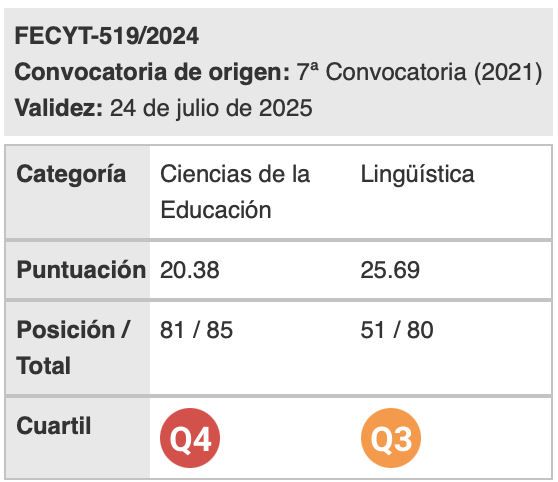The CruCES Project: A Consideration of Service Learning and Intercultural Sensitivity Among Heritage Learners
Palabras clave:
languages for specific purposes, linguistics, applied linguistics, specialised discourse, discourse studies, pragmatics, language teaching, translation, interpreting, English for specific purposes, pedagogyResumen
Though intercultural competence (ICC), community service learning (CSL), languages for specific purposes (LSP), and heritage learners (HLs) have respectively received increasing attention by language scholars within the previous twenty years, much remains to be done in the way of research concerning the relationship between them. The term HLs is used by academics in the United States in reference to students with previous knowledge of the target language and culture as a result of their cultural heritage and upbringing. This article considers the relevance of CSL to HL intercultural competence through a discussion of a 2015 community service learning project and study titled Creating Communities, Engaged Scholarship (CruCES). The project involved students and faculty from the University of Memphis, local non-profit organizations, and community members from the linguistically and ethnically diverse neighborhood of West Binghampton in Memphis, Tennessee (USA). CruCES sought to build capacity and foster community through the development of sustainable micro-economy projects centered on the arts. During the project, students also participated in a study on ISD. This paper considers the implications of the study’s findings for HLs specifically. In total, eight of the fifteen participating students self-identified as HLs. The CruCES project outcomes and study data for participating HLs are most telling with regards to their unique subjective positioning and language learning. Specifically, the study found that participating HLs demonstrated a higher degree of cultural sensitivity at the outset of the project and experienced an increase in self confidence and self-esteem related to the purposeful application of their language skills. A transformational experience for many of the HLs, the CruCES study findings hold significant implications for the development and integration of CSL in LSP courses and HL education.Descargas
Citas
Abbott, A. & Lear, D. (2010). The connections goal area in Spanish community service learning: possibilities and limitations. Foreign Language Annals, 43, 231-245.
Barreneche, G. (2011). Language learners as teachers: Integrating service learning and the advanced language course. Hispania, 94(1), 103-20.
Beaudrie, S. M. & Fairclough, M. (2012). Introduction: Spanish as Heritage Language in the United States. In S. M. Beaudrie & M. Fairclough (Eds.), Spanish as a heritage language in the United States: the state of the field (pp. 1-17). Washington, DC: Georgetown University Press.
Bennett, M. J. (1993). Towards ethnorelativism: A developmental model of intercultural sensitivity. In R. M. Paige (Ed.), Education for the intercultural experience (2nd ed., pp. 21-71). Yarmouth, ME: Intercultural Press.
Bennett, M. J. (2004). Becoming interculturally competent. In J. S. Wurzel (Ed.), Toward multiculturalism: A reader in multicultural education (2nd ed., pp. 62-77). Newton, MA: Intercultural Resource Corporation.
Bennett, M. J. (2008). On becoming global souls: Building intercultural competence. Paper presented at the First International Conference on the Development and Assessment of Intercultural Competence. Tucson, AZ: October 10-11, 2008.
Byram, M. (1997). Teaching and Assessing Intercultural Communicative Competence. Clevedon, UK: Multilingual Matters.
Byram, M. (2009). Intercultural competence in foreign languages: The intercultural speaker and the pedagogy of foreign language education. In D. Deardorff (Ed.), The sage handbook of intercultural competence (pp. 321-32). Thousand Oaks: Sage Publications.
Deardorff, D.K. (2006). Identification and assessment of intercultural competence as a student outcome of internationalization. Journal Studies in International Education, 10(3), 241-266.
Deardorff, D.K. (2009). Implementing Intercultural Competence Assessment. In Deardorff, D. (Ed.), The sage handbook of Intercultural Competence (pp. 477-91). Thousand Oaks: Sage Publications.
Deardorff, D. & Edwards K. (2013). Framing and assessing students’ intercultural competence in service learning. In P. Clayton, R. Bringle & J. Hatcher (Eds.), Research on service learning: Conceptual frameworks and assessment: Communities, institutions, and partnerships (pp. 157-83). Sterling, Va: Stylus Pub.
Ebacher, C. (2013). Taking Spanish into the community: A novice’s guide to service-learning. Hispania, 96(2), 397-408.
Falce-Robinson, J. & Strother, D. (2012). Language proficiency and civic engagement: The incorporation of meaningful service-learning projects in Spanish language courses. Interdisciplinary Humanities, 29(3), 73-87.
Grassi, E., Hanley, D. & Liston, D. (2004). Service-learning: An innovative approach for second language learners. Journal of Experiential Education, 27(1), 87-110.
Hellebrandt, J., Arries, J. & Varona, L. (2003). Juntos: Community partnerships in Spanish and Portuguese. Boston: Thomas/Heinle.
Hellebrandt, J. & Jorge, E. (2013). The scholarship of community engagement: Advancing partnerships in Spanish and Portuguese. Hispania, 96(2), 203-14.
Hellebrandt, J. & Varona, L. (1999) Construyendo puentes (building bridges): Concepts and models for service-learning in Spanish. Washington, D.C.: American Association for Higher Education.
Lafford, B. (2012). Languages for specific purposes in the United States in a global context: Commentary on Grosse and Voght (1991) revisited. The Modern Language Journal, 96, 1-27.
Lear, D. (2012). Languages for specific purposes curriculum creation and implementation in the service to the U. S. community. The Modern Language Journal, 96, 158-72.
Lear, D. & Abbott, A. (2009). Aligning expectations for mutually beneficial community service-learning: The case of Spanish language proficiency, cultural knowledge, and professional skills. Hispania, 92(2), 312-23.
Lear, D. & Sanchez, A. (2013). Sustained engagement with a single community partner. Hispania, 96(2), 238-51.
McBride, K. (2010). Reciprocity in service learning: intercultural competence through SLA studies. In B. Dupuy & L. R. Waugh (Eds.), Proceedings of Intercultural Competence Conference, August 2010 (pp. 235-261). Tucson: Center for Educational Resources in Culture, Language, and Literacy (CERCCL).
Medina, A. & Gordon, L. (2014). Service learning, phonemic perception, and learner motivation: A quantitative study. Foreign Language Annals, 47(2), 357-71.
MLA Ad Hoc Committee on Foreign Languages (2007). Foreign languages and higher education: New structures for a changed world. Profession, 12, 234-45.
National Standards Collaborative Board. (2015). World-readiness standards for learning languages, 4th edn. Alexandria: ACTFL.
Nelson, A, & Scott, J. (2008). Spanish in the university curriculum: A successful model for community-based service-Learning. Hispania, 91(2), 446-60.
Pellettieri, J. (2011). Measuring language-related outcomes of community-based learning in intermediate Spanish courses. Hispania, 94(2), 285-302.
Pérez-Llantada, C. & Watson, M. (Eds.), (2011). Specialized languages in the global village: A multi-perspective approach. Newcastle Upon Tyne: Cambridge Scholars Pub.
Rodriguez-Sabatar, S. (2015). Service learning and intercultural competence in the Spanish as a second language classroom. Southern Journal of Linguistics, 39(1), 1-23.
Ruggiero, D. M. (2015). Bridging the community and institution gap: A sample course with civic engagement and languages for specific purposes combined. Global Business Languages, 2, 35-48.
Ruggiero, D. M. (2016). The creating communities, engaged scholarship project (CruCES): Preliminary findings of a study on intercultural sensitivity and community service learning. In M.F. Litzler, J. García Laborda & C. Martínez Tejedor (Eds.), Beyond the universe of languages for specific purposes (pp. 59-64). Alcalá de Henares: Universidad de Alcalá.
Spitzberg, B. & Changnon, G. (2009). Conceptualizing intercultural competence. In D. Deardorff (Ed.), The sage handbook of intercultural competence (pp. 2-52). Thousand Oaks: Sage Publications.
Zapata, G. (2011). The effects of community service learning projects on L2 Learners’ cultural understanding. Hispania, 94(1), 86-102.
Descargas
Publicado
Cómo citar
Número
Sección
Licencia
Aquellos autores/as que tengan publicaciones con esta revista, aceptan los términos siguientes:
- Los autores/as conservarán sus derechos de autor y garantizarán a la revista el derecho de primera publicación de su obra, el cuál estará simultáneamente sujeto a la Licencia de reconocimiento de Creative Commons que permite a terceros compartir la obra siempre que se indique su autor y su primera publicación esta revista.
- Los autores/as podrán adoptar otros acuerdos de licencia no exclusiva de distribución de la versión de la obra publicada (p. ej.: depositarla en un archivo telemático institucional o publicarla en un volumen monográfico) siempre que se indique la publicación inicial en esta revista.
- Se permite y recomienda a los autores/as difundir su obra a través de Internet (p. ej.: en archivos telemáticos institucionales o en su página web) antes y durante el proceso de envío, lo cual puede producir intercambios interesantes y aumentar las citas de la obra publicada. (Véase El efecto del acceso abierto).

Revista de Lenguas para fines específicos is licensed under a Creative Commons Reconocimiento-NoComercial-SinObraDerivada 4.0 Internacional License.






















